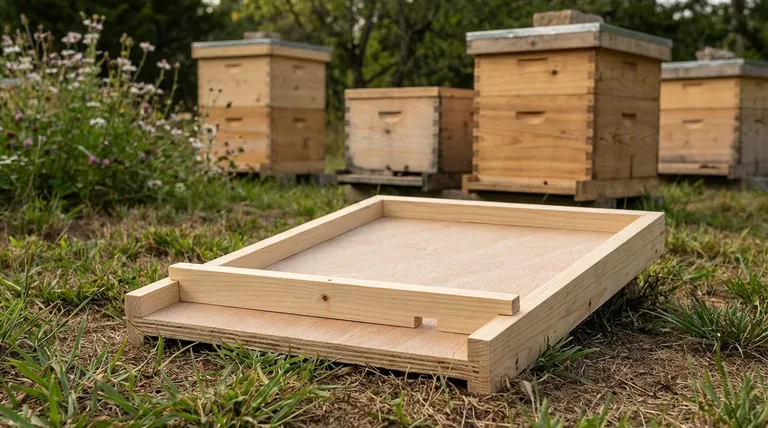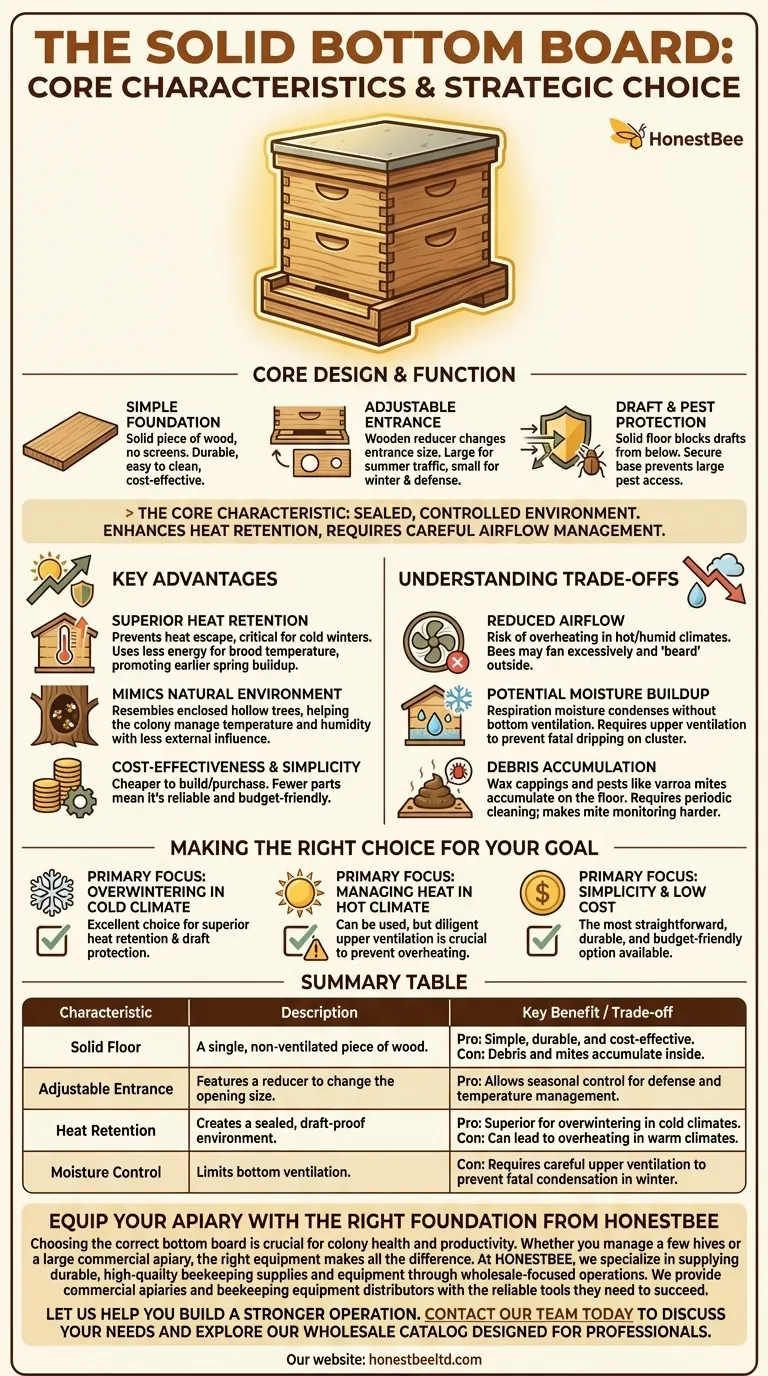A solid bottom board is the traditional, non-ventilated floor for a standard beehive, prized for its simple and durable design. It serves as the hive's foundation, providing a solid base and a single entrance for the bees. This entrance can typically be adjusted for different seasons using a wooden reducer.
The core characteristic of a solid bottom board is its ability to create a sealed, controlled environment. This enhances heat retention for the colony, but it comes at the direct cost of reduced airflow, which requires careful management.

Core Design and Function
A solid bottom board's design is defined by its simplicity. Understanding its basic components reveals its intended purpose and operational benefits for the beekeeper.
A Simple, Solid Foundation
The board itself is just what it sounds like: a solid piece of wood that forms the floor of the hive. There are no screens or openings. This straightforward construction makes it durable, easy to clean, and inexpensive.
The Adjustable Entrance
Most solid bottom boards come with a wooden cleat called an entrance reducer. This small piece allows you to change the size of the hive entrance, typically offering two options—a larger opening for high-traffic summer months and a much smaller opening for winter to conserve heat and defend against robbing.
Complete Draft and Pest Protection
Because the floor is solid, it completely blocks drafts from entering the hive from below. This design also prevents pests like mice or large insects from gaining access through the bottom, offering a secure base for the colony.
Key Advantages of a Solid Bottom
Choosing a solid bottom board offers distinct advantages, particularly for beekeepers in certain climates or with specific management goals.
Superior Heat Retention
The primary benefit is improved heat conservation. A solid floor prevents heat from escaping, which is critical during cold winters. It allows the bee cluster to use less energy maintaining brood temperature, which can lead to a stronger, earlier population buildup in the spring.
Mimics a Natural Environment
A solid bottom more closely mimics the enclosed cavities, like hollow trees, that honey bees naturally select in the wild. This protected environment helps the colony manage its own temperature and humidity with less external influence.
Cost-Effectiveness and Simplicity
Solid bottom boards are generally cheaper to build and purchase than their screened counterparts. Their simple design means there are fewer parts to break or maintain, making them a reliable and budget-friendly option for any beekeeper.
Understanding the Trade-offs
The benefits of a solid bottom board are directly linked to its primary drawback: a lack of ventilation. This requires awareness from the beekeeper.
Reduced Airflow
In hot and humid climates, the lack of ventilation can become a liability. Poor airflow can cause the hive to overheat, forcing bees to expend energy fanning and "beard" on the outside of the hive instead of foraging.
Potential for Moisture Buildup
Without bottom ventilation, moisture from the bees' respiration can condense inside the hive, especially during winter. If not properly managed with upper ventilation, this condensation can drip onto the cluster and be fatal to the colony.
Debris Accumulation
All debris, including wax cappings and pests like varroa mites, accumulates on the floor. This requires periodic cleaning and makes it more difficult to monitor mite levels compared to a screened bottom board, where mites fall through onto a sticky board for easy counting.
Making the Right Choice for Your Goal
Selecting a bottom board isn't about which is "better," but which is better suited for your specific climate and beekeeping objectives.
- If your primary focus is overwintering successfully in a cold climate: A solid bottom board is an excellent choice for its superior heat retention and draft protection.
- If your primary focus is managing heat and humidity in a hot climate: You can still use a solid bottom board, but you must be diligent about providing adequate upper ventilation to prevent overheating.
- If your primary focus is simplicity and low cost: The solid bottom board is the most straightforward, durable, and budget-friendly option available.
Choosing the right equipment is about understanding how it helps you work with your bees and your environment.
Summary Table:
| Characteristic | Description | Key Benefit / Trade-off |
|---|---|---|
| Solid Floor | A single, non-ventilated piece of wood. | Pro: Simple, durable, and cost-effective. Con: Debris and mites accumulate inside. |
| Adjustable Entrance | Features a reducer to change the opening size. | Pro: Allows seasonal control for defense and temperature management. |
| Heat Retention | Creates a sealed, draft-proof environment. | Pro: Superior for overwintering in cold climates. Con: Can lead to overheating in warm climates. |
| Moisture Control | Limits bottom ventilation. | Con: Requires careful upper ventilation to prevent fatal condensation in winter. |
Equip Your Apiary with the Right Foundation from HONESTBEE
Choosing the correct bottom board is crucial for colony health and productivity. Whether you manage a few hives or a large commercial apiary, the right equipment makes all the difference.
At HONESTBEE, we specialize in supplying durable, high-quality beekeeping supplies and equipment through wholesale-focused operations. We provide commercial apiaries and beekeeping equipment distributors with the reliable tools they need to succeed.
Let us help you build a stronger operation. Contact our team today to discuss your needs and explore our wholesale catalog designed for professionals.
Visual Guide

Related Products
- Langstroth Solid Bottom Board for Beekeeping
- Langstroth Screen Bottom Board for Beekeeping Wholesale
- Australian Pine Wood Langstroth Screen Bottom Board for Wholesale
- HONESTBEE Classic Pry Bar Hive Tool with High Visibility Finish for Beekeeping
- Professional Insulated Winter Hive Wrap for Beekeeping
People Also Ask
- How do honeybees adapt to different bottom board types in terms of temperature regulation? Optimize Your Hive Climate
- How does climate affect the choice of bottom board for a beehive? A Guide to Screened vs. Solid Boards
- What frame setups are available for the solid bottom boards? Choose the Right Foundation for Your Hive
- What factors should be considered when choosing between a solid and screened bottom board? Make the Right Choice for Your Hive's Health
- How is the solid bottom board constructed to ensure durability? Built for Longevity with Quality Wood & Beeswax



















